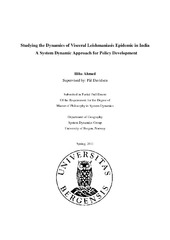Studying the dynamics of visceral leishmaniasis epidemic in India - A system dynamic approach for policy development
Master thesis
Permanent lenke
https://hdl.handle.net/1956/7395Utgivelsesdato
2011-08-23Metadata
Vis full innførselSamlinger
- Department of Geography [676]
Sammendrag
Abstract Visceral leishmaniasis, also called Kala-azar is a vector-borne infectious disease caused by the parasite Leishmania donovani. The transmission of the parasite to human beings occurs via the bite of adult female sand flies (phlebotomous) previously infected by biting and sucking blood of an infectious human being. Some of the Kala-azar patients developed a complicated condition called Post-Kala-azar Dermal Leishmaniasis (PKDL) after treatment which is also a source of infectious to sand flies. By using a system dynamics approach. A model has been developed to study the Kala-azar epidemic in India. The model in this paper describes the transmission dynamics between vectors and human beings host; it provides a deeper understanding to the transmission of Kala-azar disease as being a cyclical process. In achieving the underlying goal of removing this disease, two policies are suggested, implemented and tested; the results give us reason to believe that by implementing the two policies proposed, we will prevent (or reduce significantly) the future spread of the Kala-azar and PKDL. And thus will stop suffer from the needless illness and death which will improve the HDI. The key words: India, Kala-azar, Leishmaniasis, model, PKDL, sand fly, system dynamics
